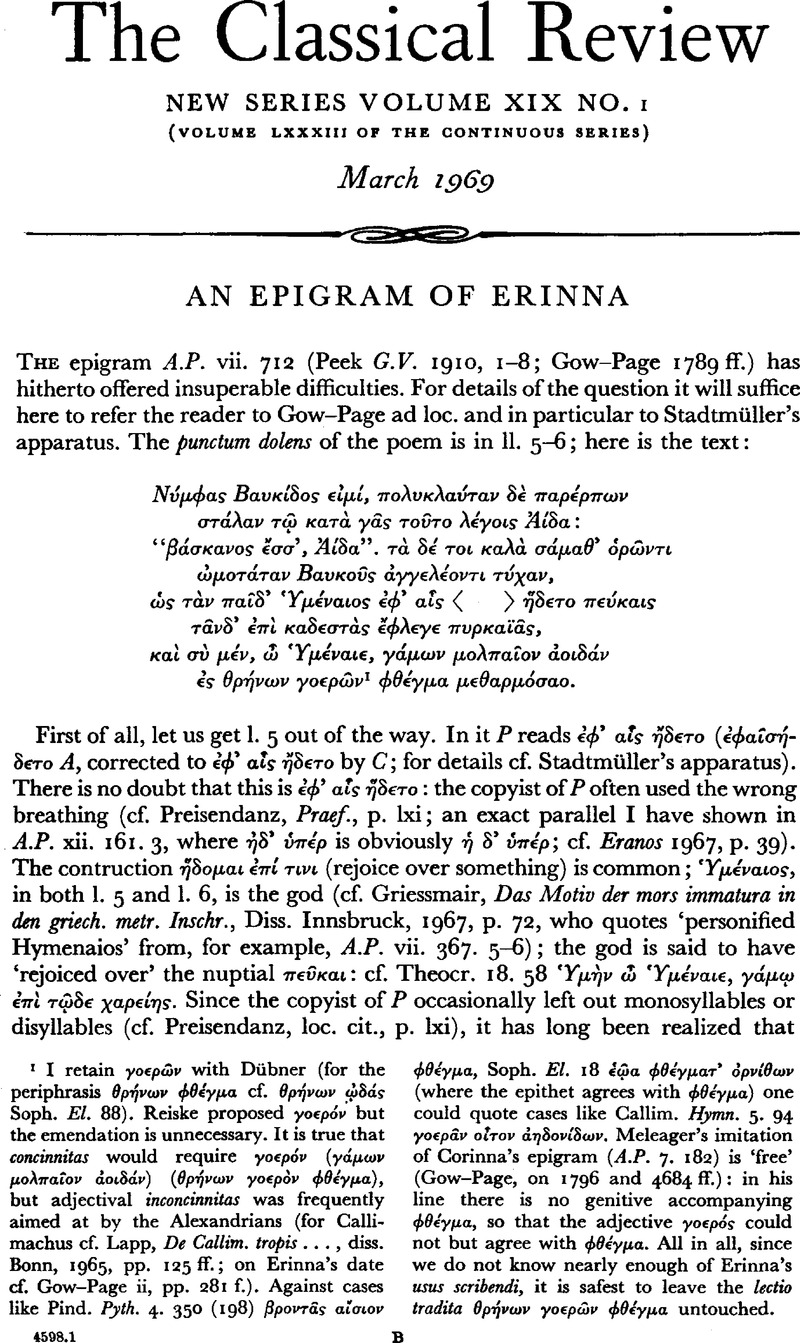No CrossRef data available.
Published online by Cambridge University Press: 27 February 2009

page 1 note 1 I retain γοερ⋯μ with Dübner (for the periphrasis θρ⋯νων φθ⋯γμα cf. θρ⋯νων ᾠδ⋯ς Soph. El. 88). Reiske proposed γοερ⋯ν but the emendation is unnecessary. It is true that concinnitas would require γοερ⋯ν (γ⋯μων μολπαῖον ⋯οιδ⋯ν) (θρ⋯νων γοερ⋯ν φθ⋯γμα), but adjectival inconcinnitas was frequently aimed at by the Alexandrians (for Callimachus cf. Lapp, De Callim. tropis …, diss. Bonn, 1965, pp. 125 ff.; on Erinna's date cf. Gow–Page ii, pp. 281 f.). Against cases like Pind. Pyth. 4. 350 (198) βροντ⋯ς αἴσιον φθ⋯γμα, Soph. El. 18 ⋯ῷα φθ⋯γματ' ⋯ρν⋯θων (where the epithet agrees with φθ⋯γμα) one could quote cases like Callim. Hymn. 5. 94 γοερ⋯ν οἶτον ⋯ηδον⋯δων. Meleager's imitation of Corinna's epigram (A.P. 7. 182) is ‘free’ (Gow–Page, on 1796 and 4684 ff.): in his line there is no genitive accompanying φθ⋯γμα, so that the adjective γοερ⋯ς could not but agree with φθ⋯γμα. All in all, since we do not know nearly enough of Erinna's usus scribendi, it is safest to leave the lectio tradita θρ⋯νων γοερ⋯ν φθ⋯γμα untouched.
page 2 note 1 Descriptive imperfects like ἥδετο and ἔφλεγε are common in the genre, cf. Gow–Page 1243 and also 1193.
page 2 note 2 Asclepiades' ὅσης and Philodemus' μεγ⋯λης seem to indicate that πυρκαϊ⋯ simply meant ‘incendium’, ‘fire’, without any implication of size: cf. Plut. Vit. 144 E, πυρκαϊ⋯ν τοσα⋯την, 749 B πυρκαϊ⋯ς τηλικα⋯της.
page 2 note 3 For such jeux d'esprit, aimed at achieving effect through the use of contextually unexepected meanings, cf., for example, C.R. lxxxi (1967), p. 130Google Scholar (Meleager'suse of ἱκ⋯της)or Eranos 1967, loc. cit. (Asclepiades' use of π⋯τασος).
page 2 note 4 Cf., for example, Peek, 1800. 8, and Kaibel, Index, s.v. πυρκαϊ⋯
page 2 note 5 Cf. πολλ⋯ν φλ⋯γα Xen. Cyr. vii. 5. 23, Arist. Nub. 1492, Plut. Vit. 475 E; φλ⋯γα πε⋯κης Eur. Bacch. 146.
page 3 note 1 The great blaze was needed for lighting purposes; from the Thesaurus (s.v.: ‘de congerie taedarum’) down to Bailly ‘amas de matières combustibles, faisceau de torches’) and L.S.J. (‘mass of burning torches’) the same mistake has been perpetuated, as if λαμπ⋯δες, used for purposes of illumination, would be burnt in one bonfire, inside a σκην⋯!
page 3 note 2 Cf. Gow–Page ad loc., for the question.
page 3 note 3 Similar tmesis in Gow-Page 1654 (= A.P. vii. 229. 4): παῖδ' ⋯π⋯ πυρκαϊ⋯ν … τιθε⋯ς.